Observation of Structural Diversity Based on the Cationic Influence in a Series of Zn/Cd Pyridine Carboxylate Coordination Compounds
Abstract
1. Introduction
2. Materials and Methods
2.1. Synthetic Methodology
2.2. Synthesis of Compounds 1 and 2
2.3. Characterization of Compounds 1 and 2
2.3.1. Elemental Analysis
2.3.2. Fourier-Transform Infrared (FT-IR) Spectroscopy
2.3.3. Powder and Single-Crystal X-ray Crystallographic Studies
3. Results
3.1. Structural Description of Compound [Zn2(L)2(H2O)4] (1)
3.2. Structural Description of Compound [Cd(L)(H2O)]n (2)
4. Conclusions and Perspectives
Supplementary Materials
Author Contributions
Funding
Institutional Review Board Statement
Informed Consent Statement
Data Availability Statement
Acknowledgments
Conflicts of Interest
References
- Chan, M.H.-Y.; Yam, V.W.-W. Toward the Design and Construction of Supramolecular Functional Molecular Materials Based on Metal–Metal Interactions. J. Am. Chem. Soc. 2022, 144, 22805–22825. [Google Scholar] [CrossRef]
- Lyu, D.; Xu, W.; Elise, J.; Payong, L.; Zhang, T.; Wang, Y. Low-dimensional assemblies of metal-organic framework particles and mutually coordinated anisotropy. Nat. Commun. 2022, 13, 3980. [Google Scholar] [CrossRef]
- Forster, P.M.; Burbank, A.R.; Livage, C.; Férey, G.; Cheetham, A.K. The role of temperature in the synthesis of hybrid inorganic–organic materials: The example of cobalt succinates. Chem. Commun. 2004, 368–369. [Google Scholar] [CrossRef]
- Dan, M.; Rao, C.N.R. A building-up process in open-framework metal carboxylates that involves aprogressive increase in dimensionality. Angew. Chem. Int. Ed. 2006, 45, 281–285. [Google Scholar] [CrossRef]
- Mahata, P.; Sundaresan, A.; Natarajan, S. The role of temperature on the structure and dimensionality of MOFs: An illustrative study of the formation of manganese oxy-bis(benzoate) structures. Chem. Commun. 2007, 4471–4473. [Google Scholar] [CrossRef]
- Gurunatha, K.L.; Uemura, K.; Maji, T.K. Temperature- and Stoichiometry-Controlled Dimensionality in a Magnesium 4,5-Imidazoledicarboxylate System with Strong Hydrophilic Pore Surfaces. Inorg. Chem. 2008, 47, 6578–6580. [Google Scholar] [CrossRef]
- Kang, J.; Abedin Khan, N.; Haque, E.; Jhung, S.H. Chemical and Thermal Stability of Isotypic Metal–Organic Frameworks: Effect of Metal Ions. Chem. Eur. J. 2011, 17, 6437–6442. [Google Scholar] [CrossRef]
- Li, H.; Davis, C.E.; Groy, T.L.; Kelley, D.G.; Yaghi, O.M. Coordinatively Unsaturated Metal Centers in the Extended Porous Framework of Zn3(BDC)3·6CH3OH (BDC=1,4-Benzenedicarboxylate). J. Am. Chem. Soc. 1998, 120, 2186–2187. [Google Scholar] [CrossRef]
- Li, H.; Eddaoudi, M.; Groy, T.L.; Yaghi, O.M. Establishing Microporosity in Open Metal-Organic Frameworks: Gas Sorption Isotherms for Zn(BDC) (BDC=1,4-Benzenedicarboxylate). J. Am. Chem. Soc. 1998, 120, 8571–8572. [Google Scholar] [CrossRef]
- Eddaoudi, M.; Li, H.; Reineke, T.; Fehr, M.; Kelley, D.; Groy, T.L.; Yaghi, O.M. Design and synthesis of metal-carboxylate frameworks with permanent microporosity. Top. Catal. 1999, 9, 105–111. [Google Scholar] [CrossRef]
- Eddaoudi, M.; Li, H.; Yaghi, O.M. Highly Porous and Stable Metal−Organic Frameworks: Structure Design and Sorption Properties. J. Am. Chem. Soc. 2000, 122, 1391–1397. [Google Scholar] [CrossRef]
- Eddaoudi, M.; Moler, D.B.; Li, H.; Chen, B.; Reineke, T.M.; ÒKeeffe, M.; Yaghi, O.M. Modular Chemistry: Secondary Building Units as a Basis for the Design of Highly Porous and Robust Metal−Organic Carboxylate Frameworks. Acc. Chem. Res. 2001, 34, 319–330. [Google Scholar] [CrossRef]
- Pan, L.; Sander, M.B.; Huang, X.; Li, J.; Smith, M.; Bittner, E.; Bockrath, B.; Johnson, J.K. Microporous Metal Organic Materials: Promising Candidates as Sorbents for Hydrogen Storage. J. Am. Chem. Soc. 2004, 126, 1308–1309. [Google Scholar] [CrossRef]
- Patel, N.; Shukla, P.; Lama, P.; Das, S.; Pal, T.K. Engineering of Metal–Organic Frameworks as Ratiometric Sensors. Cryst. Growth Des. 2022, 22, 3518–3564. [Google Scholar] [CrossRef]
- Husain, A.; Ellwart, M.; Bourne, S.A.; Ohrström, L.; Oliver, C.L. Single-Crystal-to-Single-Crystal Transformation of a Novel 2-Fold Interpenetrated Cadmium-Organic Framework with Trimesate and 1,2-Bis(4-pyridyl)ethane into the Thermally Desolvated Form Which Exhibits Liquid and Gas Sorption Properties. Cryst. Growth Des. 2013, 13, 1526–1534. [Google Scholar] [CrossRef]
- Wilson, J.A.; Uebler, J.W.; LaDuca, R.L. Cadmium adipate coordination polymers prepared with isomeric pyridylamide precursors: pH-dependent in situ reaction chemistry and divergent dimensionalities. CrystEngComm 2013, 15, 5218–5225. [Google Scholar] [CrossRef]
- Sen, R.; Saha, D.; Koner, S. Controlled Construction of Metal–Organic Frameworks: Hydrothermal Synthesis, X-ray Structure, and Heterogeneous Catalytic Study. Chem. Eur. J. 2012, 18, 5979–5986. [Google Scholar] [CrossRef]
- Nagarkar, S.S.; Chaudhari, A.K.; Ghosh, S.K. Bistable Dynamic Coordination Polymer Showing Reversible Structural and Functional Transformations. Inorg. Chem. 2012, 51, 8317–8321. [Google Scholar] [CrossRef]
- Deng, Z.-P.; Huo, L.-H.; Qi, H.-L.; Zhu, L.-N.; Zhao, H.; Gao, S. Structural diversity of Zn(ii)/Cd(ii) complexes based on bis(pyridyl) ligands with a long flexible spacer: From zero-dimensional binuclear, one-dimensional chain, two-dimensional layer, to three-dimensional frameworks. CrystEngComm 2011, 13, 4218–4227. [Google Scholar] [CrossRef]
- Wei, W.C.; Liu, Z.; Wei, R.Z.; Liang, C.X.; Feng, X.Z.; Han, G.C. Synthesis, crystal structure and anticorrosion performance of Zn(II) and Ni(II) complexes. J. Mol. Struct. 2021, 1228, 129452. [Google Scholar] [CrossRef]
- Wei, R.Z.; Liu, Z.; Wei, W.C.; Liang, C.X.; Han, G.C.; Zhan, L. Synthesis, Crystal Structure and Characterization of Two Cobalt (II) Complexes Based on Pyridine Carboxylic Acid Ligands. Z. Anorg. Allg. Chem. 2022, 648, 83–88. [Google Scholar] [CrossRef]
- Bruker. APEX 2 SAINT XPREP; Bruker AXS Inc.: Madison, WI, USA, 2007. [Google Scholar]
- Bruker. SADABS; Bruker AXS Inc.: Madison, WI, USA, 2001. [Google Scholar]
- Krause, L.; Herbst-Irmer, R.; Sheldrick, G.M.; Stalke, D. Comparison of silver and molybdenum microfocus X-ray sources for single-crystal structure determination. J. Appl. Cryst. 2015, 48, 3–10. [Google Scholar] [CrossRef]
- Kraus, W.; Nolze, G. POWDER CELL—A Program for the Representation and Manipulation of Crystal Structures and Calculation of the Resulting X-ray Powder Patterns. J. Appl. Crystallogr. 1996, 29, 301–303. [Google Scholar] [CrossRef]
- Mal, D.; Sen, R.; Brandão, P.; Lin, Z. Control formation of rigid linear and flexible zig-zig complexes based on Zn(II) and hydroxyquinoline carboxylate ligand system. Inorg. Chem. Commun. 2013, 30, 111–114. [Google Scholar] [CrossRef]
- Alvarez, S.; Alemany, P.; Casanova, D.; Cirera, J.; Llunell, M.; Avnir, D. Shape maps and polyhedral interconversion paths in transition metal chemistry. Coord. Chem. Rev. 2005, 249, 1693–1708. [Google Scholar] [CrossRef]
- Spackman, M.A.; Jayatilaka, D. Hirshfeld surface analysis. CrystEngComm 2009, 11, 19–32. [Google Scholar] [CrossRef]
- Spackman, P.R.; Turner, M.J.; McKinnon, J.J.; Wolff, S.K.; Grimwood, D.J.; Jayatilaka, D.; Spackman, M.A. CrystalExplorer: A program for Hirshfeld surface analysis, visualization and quantitative analysis of molecular crystals. J. Appl. Cryst. 2021, 54, 1006–1011. [Google Scholar] [CrossRef]
- Grabowski, S.J. Analysis of Hydrogen Bonds in Crystals. Crystals 2016, 6, 59. [Google Scholar] [CrossRef]
- Sutor, D.J. The C-H…O hydrogen bond in crystals. Nature 1962, 195, 68–69. [Google Scholar] [CrossRef]
- Mal, D.; Sen, R.; Brandão, P.; Shi, F.N.; Ferreira, R.A.S.; Lin, Z. Auxiliary ligand-assisted structural diversities of two coordination polymers with 2-hydroxyquinoline-4-carboxylic acid. Inorg. Chem. Commun. 2013, 40, 92–96. [Google Scholar] [CrossRef]
- Gurunatha, K.L.; Maji, T.K. Three isomorphous threefold interpenetrated 2D supramolecular frameworks: Synthesis, structure and sorption properties. Inorg. Chim. Acta 2009, 362, 1541–1545. [Google Scholar] [CrossRef]
- Wei, W.C.; Liu, Z.; Wei, R.Z.; Han, G.C.; Liang, C.X. Synthesis of MOFs/GO composite for corrosion resistance application on carbon steel. RSC Adv. 2020, 10, 29923–29934. [Google Scholar] [CrossRef]
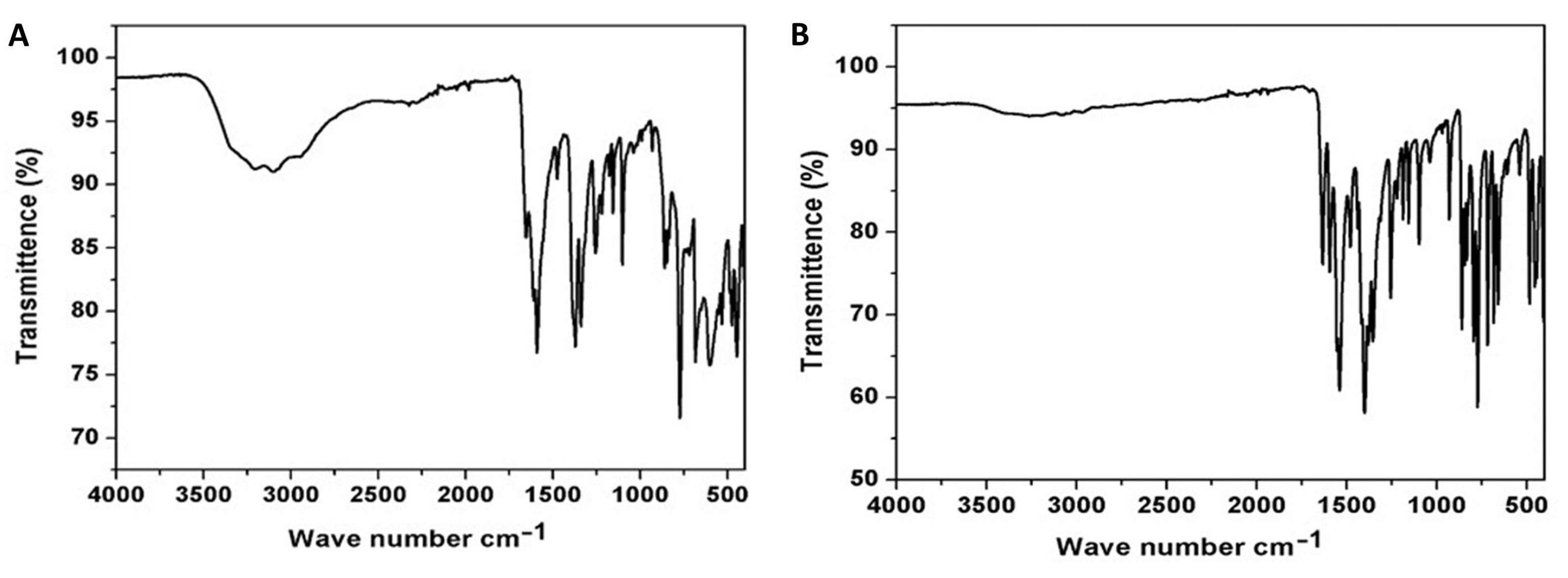
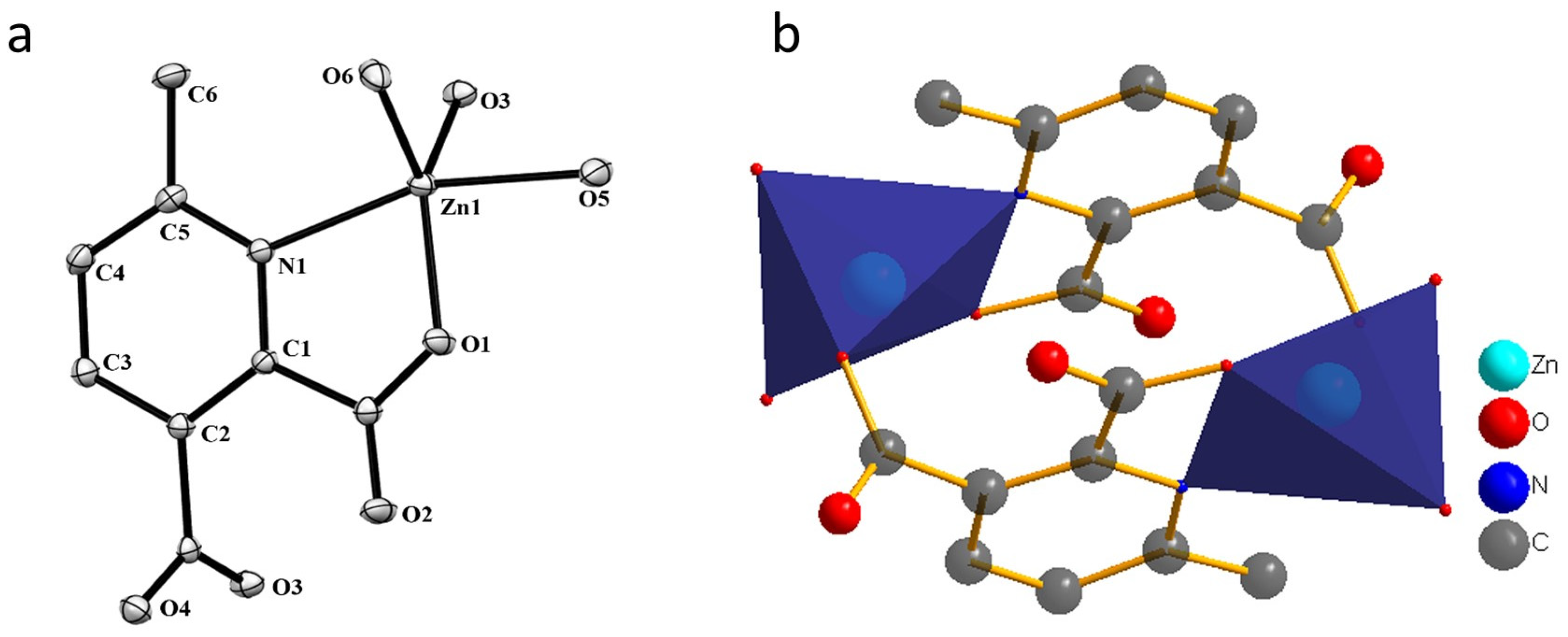

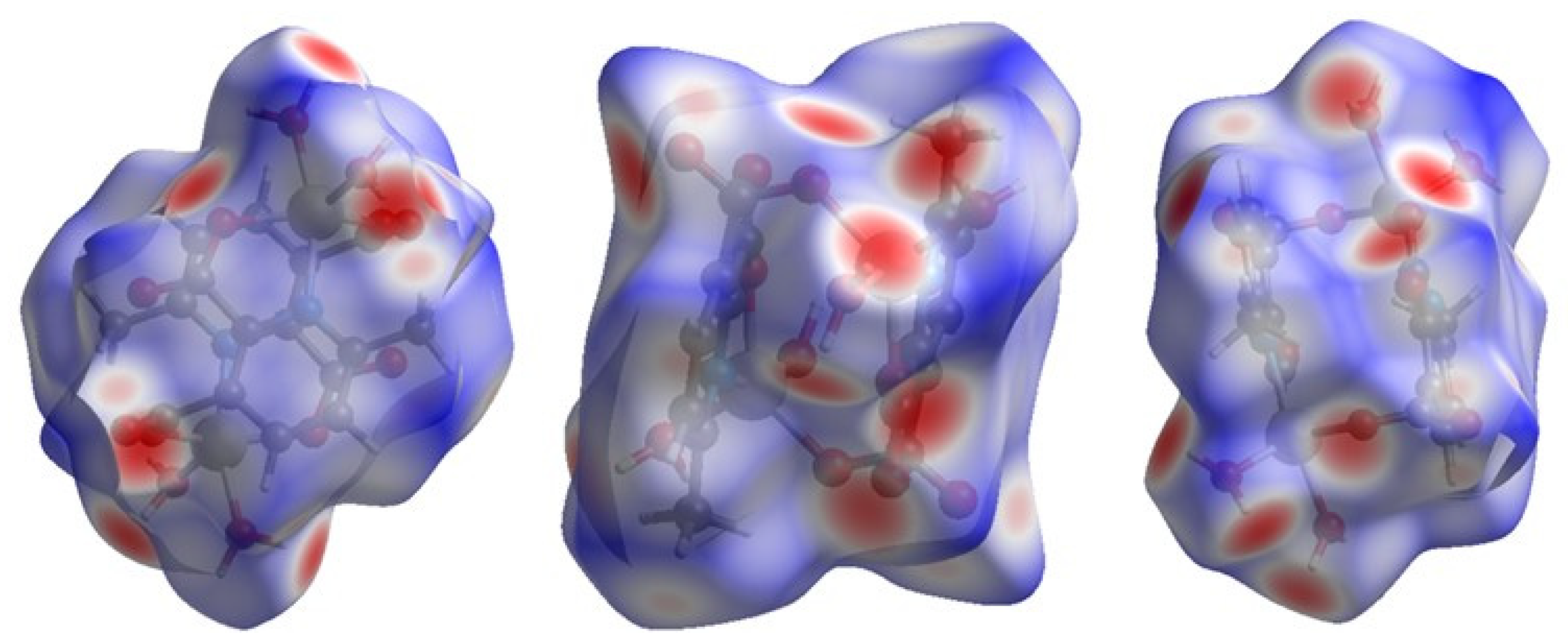

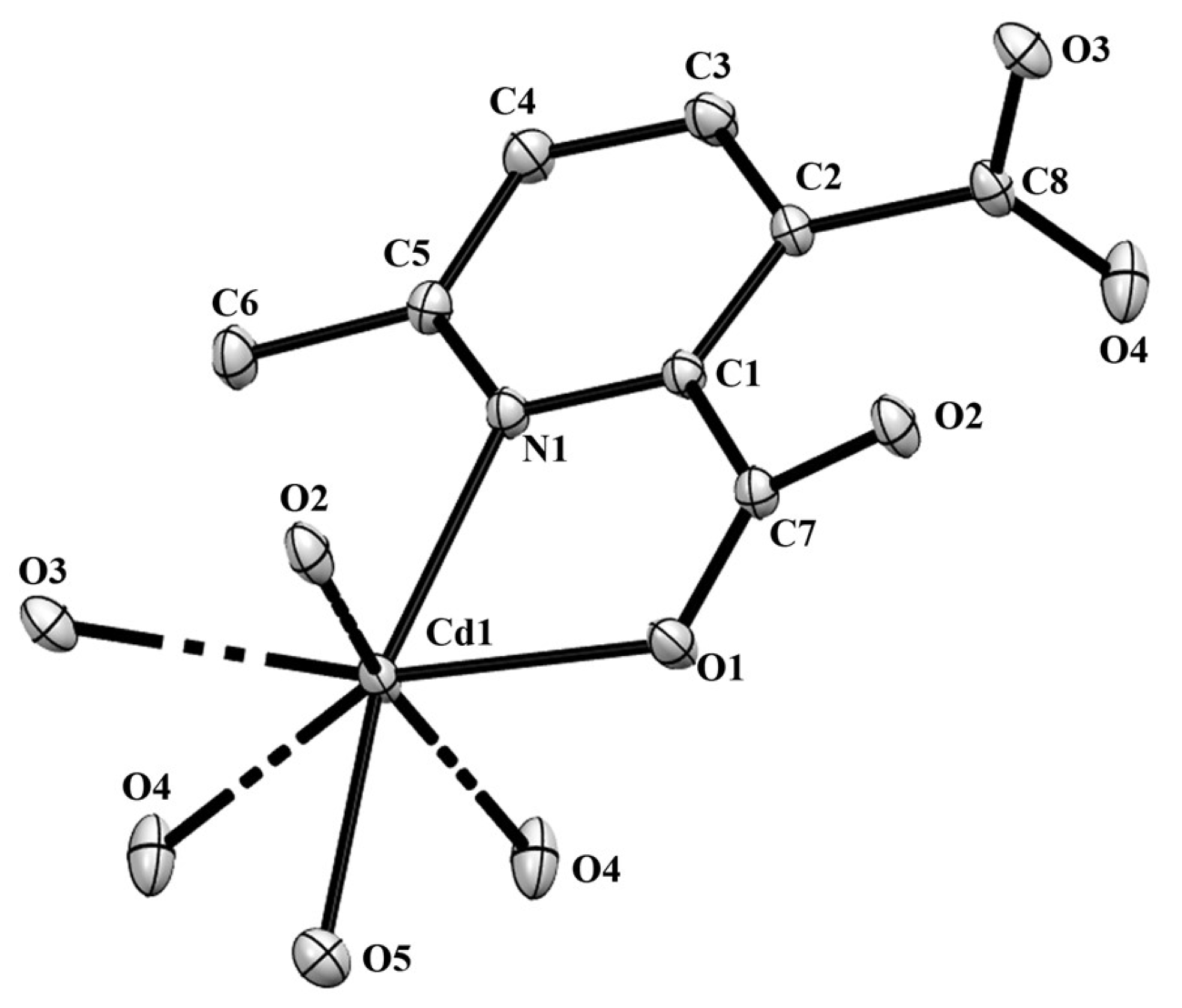

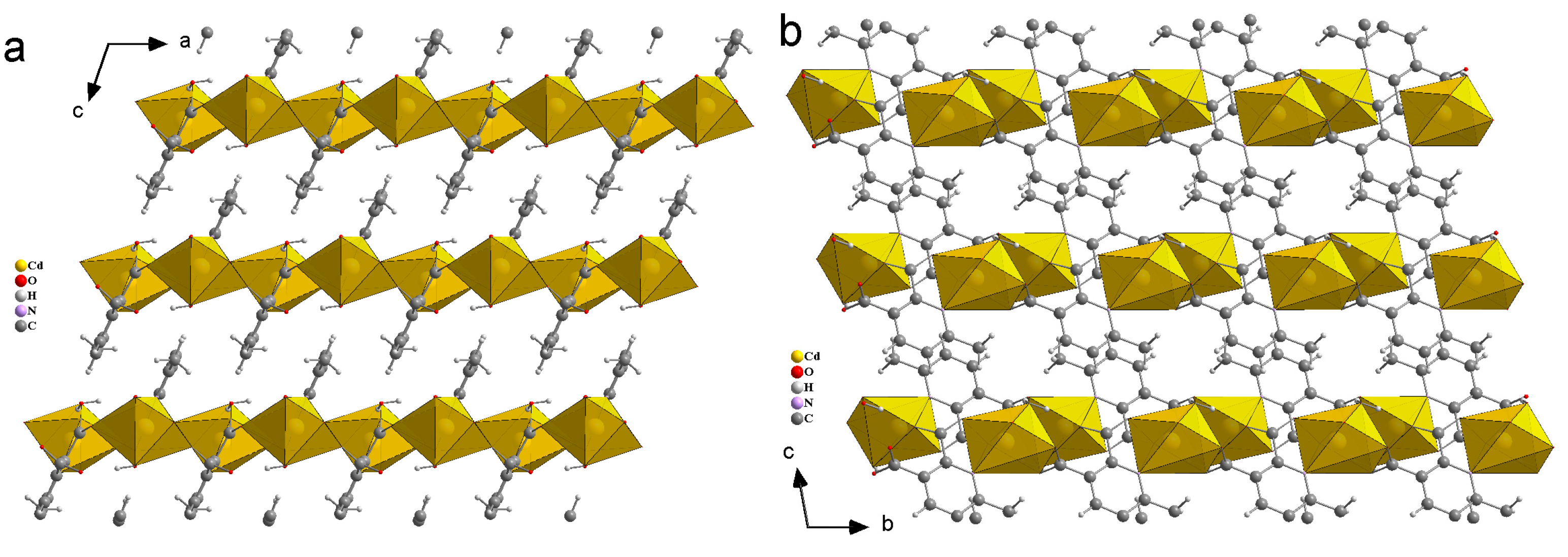
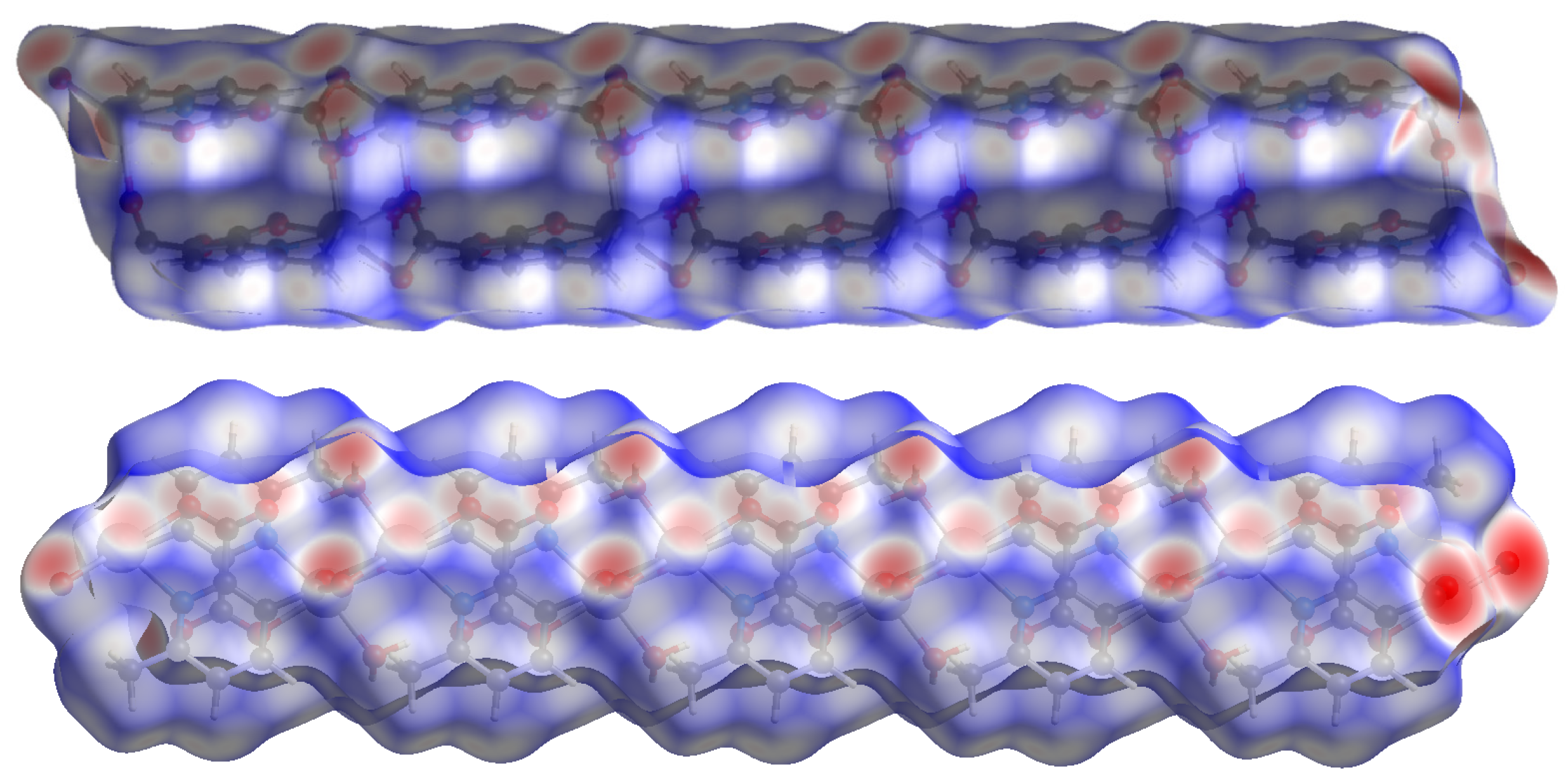
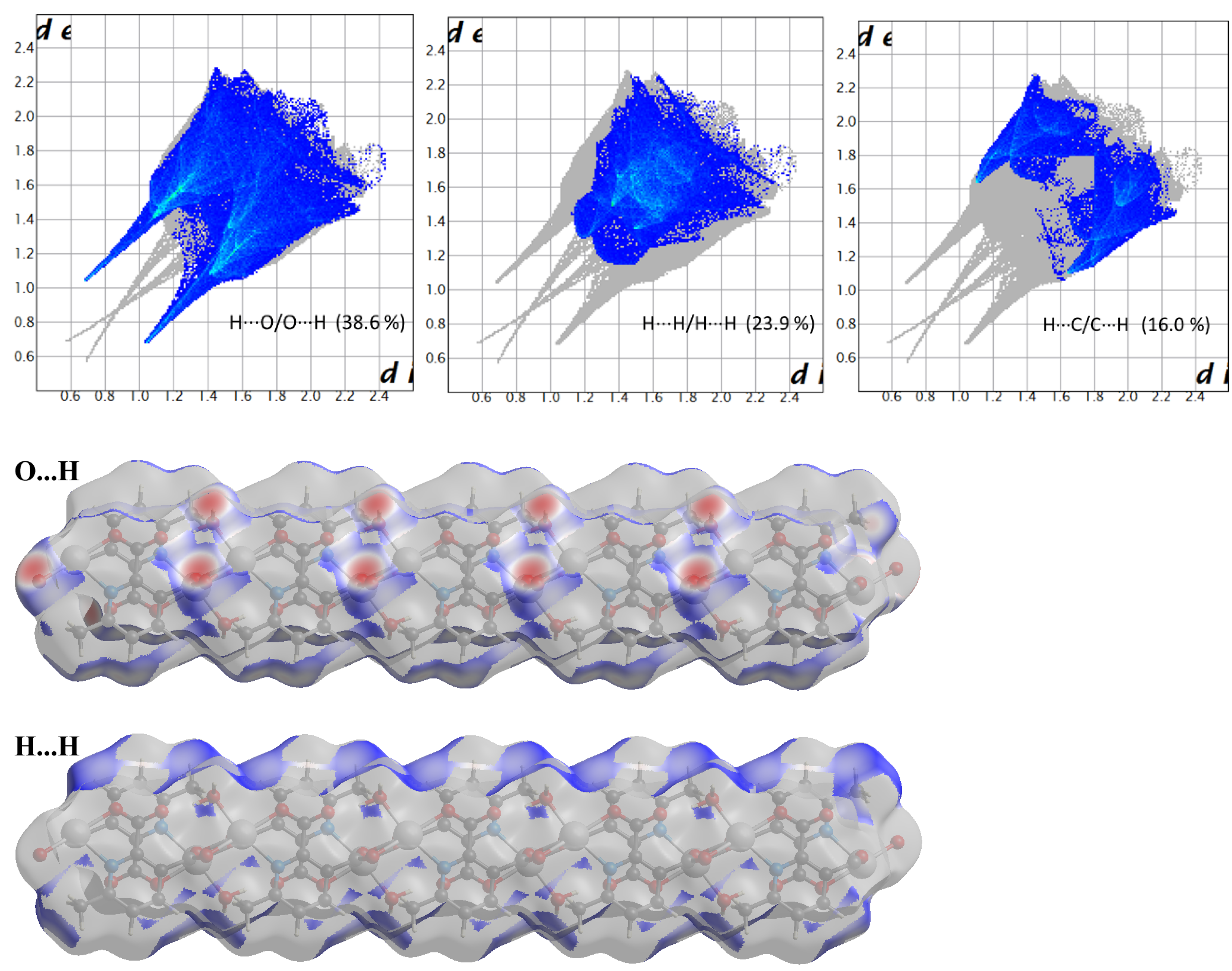

| % | Calculated | Found | ||
|---|---|---|---|---|
| 1 | 2 | 1 | 2 | |
| C | 34.22 | 31.05 | 34.92 | 30.75 |
| H | 3.20 | 2.28 | 3.32 | 2.85 |
| N | 4.99 | 4.52 | 4.89 | 4.97 |
| Compound | 1 | 2 |
|---|---|---|
| Formula | C16H18N2O12Zn2 | C8H7NO5Cd |
| Formula Weight | 561.06 | 309.56 |
| Temperature (K) | 293(2) | 293(2) |
| Wavelength (Å) | 0.71073 | 0.71073 |
| Crystal System | Monoclinic | Triclinic |
| Space group | P21/c | |
| a (Ǻ) | 7.1923(4) | 7.3698(2) |
| b (Ǻ) | 14.7691(8) | 7.9846(2) |
| c (Ǻ) | 8.8998(5) | 8.0498(2) |
| α, β, γ (°) | 90, 93.487(2), 90 | 94.969(10), 106.898(10), 105.817(10) |
| Volume (Å3) | 943.62(9) | 428.942(19) |
| Calculated density (g·cm−3) | 1.975 | 2.397 |
| Z | 2 | 1 |
| θ range for data collection (°) | 2.68–30.60 | 2.69–33.27 |
| F(000) | 568 | 300 |
| Absorption coefficient (mm−1) | 2.616 | 2.545 |
| Unique reflections | 2906 | 3286 |
| R1, wR2 [I > 2σ(I)] | 0.0221, 0.0568 | 0.0166, 0.0395 |
| Goodness of fit (S) | 1.066 | 1.051 |
| Bond Lengths (Å) | Bond Angles (°) | ||
|---|---|---|---|
| Compound 1 | |||
| Zn1-O1 | 1.989(1) | O1-Zn1-O4 | 120.78(5) |
| Zn1-O4 | 1.966(1) | O1-Zn1-N1 | 78.67(5) |
| Zn1-N1 | 2.166(1) | O1-Zn1-O3 | 84.08(5) |
| Zn1-O3 | 2.133(1) | O1-Zn1-O5 | 135.47(5) |
| Zn1-O5 | 1.988(1) | O3-Zn1-O5 | 91.08(5) |
| Compound 2 | |||
| Cd1—O1 | 2.2581(10) | O5—Cd1—O4 ii | 87.43(4) |
| Cd1—O5 | 2.2884(10) | N1—Cd1—O4 ii | 86.31(4) |
| Cd1—N1 | 2.3108(11) | O3 i—Cd1—O4 ii | 118.63(4) |
| Cd1—O3 i | 2.3678(10) | O1—Cd1—O4 i | 149.92(4) |
| Cd1—O4 ii | 2.4183(11) | O5—Cd1—O4 i | 73.56(4) |
| Cd1—O4 i | 2.5031(11) | N1—Cd1—O4 i | 113.99(4) |
| Cd1—O2 iii | 2.5553(11) | O3 i—Cd1—O4 i | 53.47(3) |
| O1—Cd1—O5 | 94.33(4) | O4 ii—Cd1—O4 i | 67.18(4) |
| O1—Cd1—N1 | 73.99(4) | O1—Cd1—O2 iii | 77.66(3) |
| O5—Cd1—N1 | 167.16(4) | O5—Cd1—O2 iii | 80.44(4) |
| O1—Cd1—O3 i | 156.02(4) | N1—Cd1—O2 iii | 101.71(4) |
| O5—Cd1—O3 i | 89.78(4) | O3 i—Cd1—O2 iii | 79.76(3) |
| N1—Cd1—O3 i | 103.06(4) | O4 ii—Cd1—O2 iii | 158.08(4) |
| O1—Cd1—O4 ii | 85.19(4) | O4 i—Cd1—O2 iii | 125.32(3) |
| Polyhedron Shape | Symmetry | CSHM Value |
|---|---|---|
| Pentagon | D5h | 28.454 |
| Vacant octahedron | C4v | 4.061 |
| Trigonal bipyramid | D3h | 2.391 |
| Spherical square pyramid | C4v | 2.724 |
| Johnson trigonal bipyramid J12 | D3h | 3.975 |
| Polyhedron Shape | Symmetry | CSHM Value |
|---|---|---|
| Heptagon | D7h | 28.604 |
| Hexagonal pyramid | C6v | 19.347 |
| Pentagonal bipyramid | D5h | 3.689 |
| Capped octahedron | C3v | 5.047 |
| Capped trigonal prism | C2v | 3.703 |
| Johnson pentagonal bipyramid J13 | D5h | 6.495 |
| Johnson elongated triangular pyramid J7 | C3v | 19.422 |
Disclaimer/Publisher’s Note: The statements, opinions and data contained in all publications are solely those of the individual author(s) and contributor(s) and not of MDPI and/or the editor(s). MDPI and/or the editor(s) disclaim responsibility for any injury to people or property resulting from any ideas, methods, instructions or products referred to in the content. |
© 2023 by the authors. Licensee MDPI, Basel, Switzerland. This article is an open access article distributed under the terms and conditions of the Creative Commons Attribution (CC BY) license (https://creativecommons.org/licenses/by/4.0/).
Share and Cite
Sen, R.; Banerjee, A.; Brandão, P.; Lin, Z. Observation of Structural Diversity Based on the Cationic Influence in a Series of Zn/Cd Pyridine Carboxylate Coordination Compounds. Crystals 2023, 13, 186. https://doi.org/10.3390/cryst13020186
Sen R, Banerjee A, Brandão P, Lin Z. Observation of Structural Diversity Based on the Cationic Influence in a Series of Zn/Cd Pyridine Carboxylate Coordination Compounds. Crystals. 2023; 13(2):186. https://doi.org/10.3390/cryst13020186
Chicago/Turabian StyleSen, Rupam, Abhishek Banerjee, Paula Brandão, and Zhi Lin. 2023. "Observation of Structural Diversity Based on the Cationic Influence in a Series of Zn/Cd Pyridine Carboxylate Coordination Compounds" Crystals 13, no. 2: 186. https://doi.org/10.3390/cryst13020186
APA StyleSen, R., Banerjee, A., Brandão, P., & Lin, Z. (2023). Observation of Structural Diversity Based on the Cationic Influence in a Series of Zn/Cd Pyridine Carboxylate Coordination Compounds. Crystals, 13(2), 186. https://doi.org/10.3390/cryst13020186







